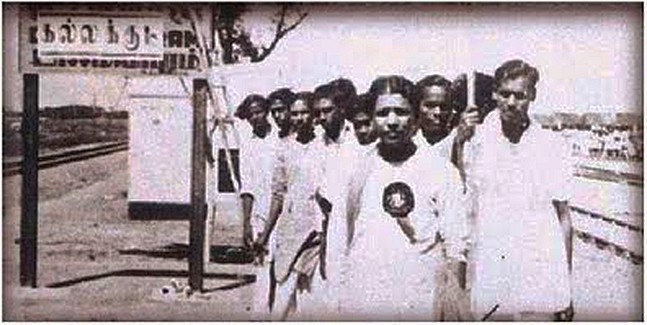Protests movement in India could be traced back to nearly 200 years ago with the formation of the Academic Association in undivided Bengal’s Hindu College under the guidance of Henry Louis Vivian Derozio, a teacher there and a reformer, in 1828.
Anti-Hindi movement in Tamil Nadu, 1965
the protest against Hindi had been going on for decades in Tamil Nadu, it became a flashpoint when a large number of students across the state launched a stir against the Official Languages Act of 1963, which made Hindi an official language along with English. Despite protests by the Dravida Munnetra Kazhagam (DMK) in Parliament.
Nav Nirman Andolan, 1974
On December 20, 1973, students of an engineering college in Ahmedabad launched an agitation against a 20% fee hike in hostel food. A similar strike on January 3, 1974, at Gujarat University saw clashes between the police and students. The protesters demanded the resignation of then chief minister Chimanbhai Patel.
Bihar student movement, 1974 (also called JP movement)
The Chatra Sangarsh Samiti led by Jai Prakash Narayan focused on corruption, nepotism, electoral reforms, subsidized food and education reforms. It was a non-violent protest, which started from Patna University and spread to several other educational institutes in Hindi-speaking states of northern India. Nitish Kumar, now the Bihar chief minister; Lalu Prasad, a former Bihar CM;
Student movement in Emergency, 1975
In several universities and academic institutions across India, students and faculty members organized underground protests, using pamphlets and leaflets to protest against the imposition of Emergency. Over 300 student union leaders, including then Delhi University Students Union president Arun Jaitley and Jai Prakash Narayan, who headed the Chatra Sangarsh Samiti, were sent to jail.
Assam Agitation (1979 to 1985)
The agitation in Assam against illegal migrants was launched by the All Assam Students Union, which is now spearheading protests against the amended citizenship act. It was an agitation to protect the identity of Assamese people in the wake of an influx of people from Bangladesh following 1971’s War of Liberation. People from different walks of life joined the students’ protests,
Anti-reservation protests, 2006
In August 1990, students from across India started a protest against the introduction of a 27% reservation in government jobs for people from the Other Backward Classes. The government, led by VP Singh, implemented the Mandal Commission recommendations submitted to the government in 1980. Although the protest began at Delhi University,
FTII agitation, 2015
It was a second major protest against the reservation system. In 2006, widespread protests took place in educational institutes oppose the decision of Congress-led United Progressive Alliance government to implement reservations for OBCs in both central and private higher education institutes. Students and doctors belonging to upper castes called the move discriminatory. There were counter-protests in favor of the decision by OBC student groups.
Jadavpur University, 2014
The “hok kalorob (let there be uproar)” movement at Jadavpur University was against alleged police attack on unarmed students. The students were demanding a fair inquiry into the alleged molestation of a student inside the campus. The week-long protest led to the removal of vice-chancellor Abhijit Chakraborty, who had allegedly allowed police to enter the campus.
Protest over Rohith Vemula’s death, 2016
The suicide of a Dalit scholar of Hyderabad University, Rohith Vermula, triggered a nationwide outrage against the university administration over alleged failure to prevent his suicide. The suicide took place days after the university’s executive council expelled five Dalit students, including Vemula, from the hostel and limited their access to the campus for allegedly assaulting an ABVP student leader. Hundreds of students from universities across India participated in protest rallies.
JNU protest, 2016
On February 9, 2016, Jawaharlal Nehru University (JNU) erupted in protests over the 2013 execution of Afzal Guru, a Kashmiri separatist convicted of conspiring in an attack on Parliament 16 years ago. Many human rights groups felt was flawed. The demonstration witnessed clashes between different student groups. Four days after the event, then JNU students’ union president Kahhaiya Kumar was arrested by Delhi Police and booked for sedition.
Jamia Millia Islamia University protest, 2019
Citizenship Amendment Act (CAA) Today News Updates: As tensions remain high across the nation over the amended Citizenship Act with internet blocked and tight security, protests in parts of western Uttar Pradesh including — Bulandshahr, Meerut and Muzaffarnagar — turned violent Friday. Protesters torched several vehicles in Bulandshahr, More than 15 districts in UP witnessed clashes between the police and protesters.


 Ranbir Kapoor3 weeks ago
Ranbir Kapoor3 weeks ago
 Sunny Leone2 weeks ago
Sunny Leone2 weeks ago
 Mahakumbh2 weeks ago
Mahakumbh2 weeks ago
 Parineeti Chopra3 weeks ago
Parineeti Chopra3 weeks ago
 Pahalgam Attack2 weeks ago
Pahalgam Attack2 weeks ago
 American Dream6 days ago
American Dream6 days ago.jpg)
.jpg) Bollywood6 days ago
Bollywood6 days ago
 UP Board Result 20252 weeks ago
UP Board Result 20252 weeks ago







.1.jpg)









